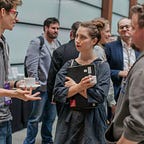Digitise, but for the right reasons
…or how and why the National Gallery of Denmark is opening up to its audiences
Let’s Start At The Beginning
Few people know that the visions set to guide cultural institutions, such as museums, are not just about the works of art themselves. They are about promoting culture, and building communities who are familiar with their past. There are many means to that end, and physically exhibiting the contents of a museum’s collection is just one of them.
One of the foundational principles of the Smithsonian, currently the world’s largest museum, is “the increase and diffusion of knowledge”. The Tate, on the other hand, aims to “make us all aware of the significance of the visual in contemporary life and how artists help us to see and interpret the world”. The National Gallery of Denmark (the SMK) recognised as the principal Danish cultural heritage institution has a clear community building purpose, and promotes specific values: creativity and self-reflection.
Wildest Dreams
Try this. Keep in mind the reasoning behind why our cultural institutions as we know them today exist. Now, think of how their guiding principles could play best in the modern context. Let’s zoom into what “the SMK wants” and picture people being creative and reflective through and thanks to Danish and European art.
What do you see? Is it just large queues in front of the entrance? Or maybe paintings consciously used as cover pictures on Facebook? Moving toward deeper engagement with the contemporary media landscape, could a SKAM character (check out this Norwegian multimedia series if you haven’t already) sending out an art inspired emoji to his boyfriend be what we are looking for? SMK staff says — “yes”.
A dream of Jonas Heide Smith who leads the Digital Department is “a young person living *far* away from the museum going out of their way and using our images on an everyday object, such as a t-shirt or an iPad cover.”
Merete Sanderhoff, SMK’s senior advisor and curator and a member of the Europeana Board adds that for her, it “could be someone grabbing an SMK image and reenacting it with their friends (for instance in VanGoYourself), or someone making a fun or beautiful even thought-provoking GIF and putting it online.” Simple. Or is it?
SMK Open
Even these modest dreams, dreams that do not even getting close to the peak of technological hysteria of “apps can save us”, are based on certain assumptions. First and foremost is that “the content” — art, our cultural heritage, is available and ready to be used without restrictions. What does available mean nowadays? It means that you can easily find it online in high resolution, well described, tagged and up for grabs through an API. That is just and as much as, the base. The world is out there, online.
SMK Open is about making all these assumptions become reality, so that the dreams can follow. The project kicked off 2 months ago and is planned to last four years. Its purpose is to make all of the *digitised* collection (42 000 pieces) fully available online, to humans and machines.
SMK Open is lead by Christina Jensen. Four years to make available 700 years of art stored within the walls of SMK is an ambitious, complex and impressive attempt. It also is a very long time. A lot can change on the way, including the techscape, and it is impossible to be prepared for that.
The Developer’s Blog
The project team includes one full-time database programmer and will have two more techies potentially joining down the line. I will be here every week to tell you about SMK Open struggles and victories.
No Master Narratives. Instead, I will focus on the naturally occurring chaos and disorder of the universe.
During the first stage of the project, some 40,000 works will be made accessible. Approximately 15,000 of these will be available as high-resolution files ready to be used in books, teaching materials, online blogs, Wikipedia articles, film and TV productions. Anything is possible.
Welcome to the SMK Open developer’s blog, stay tuned.
